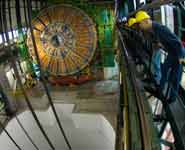Today, Wednesday 10 September 2008, the largest scientific experiment in the world will officially start, with University of Bristol scientists at the forefront.
The experiment will recreate conditions that existed just a billionth of a second after the Big Bang, and seek answers to some of the deepest mysteries of the origins and workings of our universe.
Scientists from the Department of Physics, funded by the Science and Technology Facilities Council, have been working for over 15 years to help construct the new experiment, as part of a large international team. Apparatus designed and built in Bristol is now operational at the Large Hadron Collider (LHC), and will play a vital part when the machine is turned on.
“The experiments at the LHC are the most challenging we’ve ever attempted, and the results could revolutionise our understanding of nature,” said Dr Dave Newbold, who works on the project. “The University also has a key role in interpreting the data, and some of the first discoveries could be made in Bristol.”
The new LHC particle accelerator is housed in a giant laboratory at CERN, buried 100m below mountains on the Swiss-French border. Tiny particles, colliding at almost the speed of light, will allow researchers to tackle to some of the biggest questions in science.
Professor Nick Brook explained what they will be looking for: “How and why does the Universe exist? Where is the missing key to the laws of nature – the Higgs Boson? Can we identify the unknown particle or phenomenathat makes up over 90 per cent of the Universe?! Can we unlock the mystery of anti-matter - why do we live in a world of just matter?”
Once the accelerator is switched on, work at Bristol will focus on the interpretation of the vast amount of data produced by the LHC – enough to create a 20km high tower of CDs every year. New scientific results, eagerly awaited by scientists around the world, are expected to be announced within a year of the first collisions.
Crucial parts of the two detectors known as the CMS and LHCb, have been designed and constructed by Bristol scientists and students working locally and in Geneva.
The detectors are similar to vast digital cameras, and can record the results of particle collisions up to 40 million times per second. The Bristol team has contributed new sensors that can precisely measure the collision fragments, vital for the discovery of the missing keys to the laws of nature.
A second major achievement is the harnessing together, for the first time, of some of the world’s largest computers, including the University’s brand new High Performance computer here in Bristol, to analyse the data from the experiments. These facilities use tools developed by scientists at Bristol University, along with international collaborators. The new technology will also have important spin-offs in other areas of science, medicine and industry.
The University gained a Nobel prize in particle physics in 1950 for the discovery of a subatomic particle called the ‘pion’; the new work at the LHC is potentially of similar importance.
